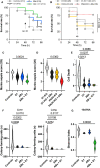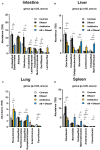DNases improve effectiveness of antibiotic treatment in murine polymicrobial sepsis
- PMID: 38259485
- PMCID: PMC10801052
- DOI: 10.3389/fimmu.2023.1254838
DNases improve effectiveness of antibiotic treatment in murine polymicrobial sepsis
Abstract
Introduction: Neutrophil extracellular traps (NETs) have various beneficial and detrimental effects in the body. It has been reported that some bacteria may evade the immune system when entangled in NETs. Thus, the aim of the current study was to evaluate the effects of a combined DNase and antibiotic therapy in a murine model of abdominal sepsis.
Methods: C57BL/6 mice underwent a cecum-ligation-and-puncture procedure. We used wild-type and knockout mice with the same genetic background (PAD4-KO and DNase1-KO). Mice were treated with (I) antibiotics (Metronidazol/Cefuroxime), (II) DNAse1, or (III) with the combination of both; mock-treated mice served as controls. We employed a streak plate procedure and 16s-RNA analysis to evaluate bacterial translocation and quantified NETs formation by ELISA and immune fluorescence. Western blot and proteomics analysis were used to determine inflammation.
Results: A total of n=73 mice were used. Mice that were genetically unable to produce extended NETs or were treated with DNases displayed superior survival and bacterial clearance and reduced inflammation. DNase1 treatment significantly improved clearance of Gram-negative bacteria and survival rates. Importantly, the combination of DNase1 and antibiotics reduced tissue damage, neutrophil activation, and NETs formation in the affected intestinal tissue.
Conclusion: The combination of antibiotics with DNase1 ameliorates abdominal sepsis. Gram-negative bacteria are cleared better when NETs are cleaved by DNase1. Future studies on antibiotic therapy should be combined with anti-NETs therapies.
Keywords: NETs; abdominal sepsis; appendicitis; biomarker; extracellular traps; neutrophils; prospective.
Copyright © 2024 Willemsen, Wenskus, Lenz, Rhode, Trochimiuk, Appl, Pagarol-Raluy, Börnigen, Bang, Reinshagen, Herrmann, Elrod and Boettcher.
Conflict of interest statement
MB and MH serve as a Medical Advisor of Neutrolis, Cambridge, MA, USA that focuses on developing therapies against NETs. Both are stakeholders of Neutrolis. No compounds from Neutrolis were used in this study. The remaining authors declare that the research was conducted in the absence of any commercial or financial relationships that could be construed as a potential conflict of interest.
Figures



References
MeSH terms
Substances
LinkOut - more resources
Full Text Sources
Medical
Molecular Biology Databases
Research Materials

